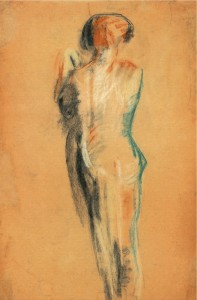P. A. Florensky attended the first Way of Painting exhibition. L. F. Zhegin recalled his visit in the following words:
“He was present at our little Way of Painting exhibition that was held in a private apartment on Serebryany Lane. This was in 1927.
Florensky didn’t like my pal P. Babichev’s works: they seemed too impressionistic to him, and he was drawn to highly constructive work. “Everything’s floating about here,” he noted. I never agreed with that characterization: in my opinion Babichev was, of course, a painter and as such was able to organize form.
Then he turned to V. Koroteev’s pastel work: a grown female figure in very beautiful colors. He pointed out the motivation in the color choice: the entire figure was portrayed in a light ochre-rose tone while the head was in light-green shades. Florensky explained that the body, which is an expression of gender, and the head are two different realms, which is expressed here in color: the green color dematerializes, it is connected with the intellect, with the realm of the head.” [4]
Florensky was talking about one of Koroteev’s works from the 1920s, created using charcoal and crayons. Koroteev’s works from that period attest to the fact that he was still under the influence of both his teacher L. F. Zhegin as well as V. N. Chekrygin; we’re talking about a malleable influence, about the fact that the young artist was given over entirely to the artistic language that he studied. This is that very language and that very place in the field of art and, perhaps, a very precise intonation in conveying the state of language and space. But he speaks in this language about his own vision of the living, real world. For him, this language is not a dead, plaster cast, not a reference standard, but rather a living material in which he approaches the epitome of his life experience. These works are only partially the imprints or shadows of studied, bookish history; they are simultaneously the outlines, taking shape, of a new, unclear life that has not yet come to fruition, of an imminent future and of another time. Its saints, its resurrected souls are those same, familiar vagrants and children of the streets; but these are sunny pink- and sky blue-colored streets, a new, shining, crystal-clear world that they have attained. With the passage of time the paintings will no longer be so full of color and the landscapes will darken, but they will nevertheless retain its sparkle or gleam, as a portrayal of the meaning of the world’s youth, which is revealed over and over by art; the un-lost connection with the dawn of the cosmos, the first days of creation, when everything within it was still radiant. Each painting’s creation is like the end to an old universe and the birth of a new one. This is the meaning of art.
____________________
[4] — Makovets. 1922-1926. Sbornik materialov po istorii obedineniya (Collection of Works on the History of the Association). Moscow, 1994- P. 105.



